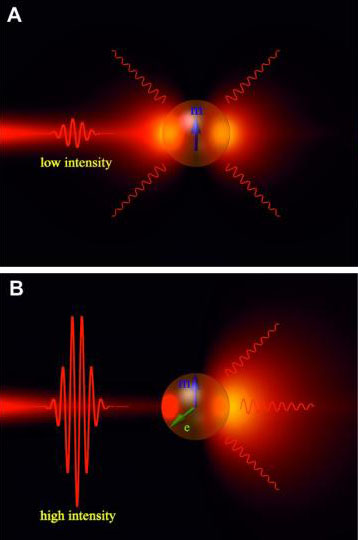
A silicon nanoparticle, illuminated by a high-intensity laser pulse, can act as an optical switch. [Image: Makarov et al., Nano Lett., doi: 10.1021/acs.nanolett.5b02534]
Ultrafast optical computers will require compact, ultrafast optical switches, which allow for control of beam propagation in nanoscale photonic circuits. A team of scientists in Russia has proposed a novel approach to such switching that involves tuning the optical properties of cheap silicon nanoparticles using femtosecond laser irradiation (Nano Lett., doi: 10.1021/acs.nanolett.5b02534). If realized, the result would allow the scattering direction of light off the nanoparticle to be controlled by varying the intensity of the incident beam—analogous to the control of electron flow through current variations in a transistor.
The team’s concept relies on the ability to use intense, ultrashort laser light pulses to induce a dense, transient electron-hole plasma in the nanoparticle. The pulse dramatically alters the dielectric permittivity of the nanoparticle—which, in turn, opens up a window of several picoseconds in which the optical properties of the particle change, owing to patterns of interference between the magnetic and electric modes of displacement currents excited inside the nanoparticle. This allows for control of specific optical properties such as the direction of scattering off the nanoparticle, with the direction (for example, forward or backward scattering) dependent on the plasma density and thus, indirectly, on the intensity of the incident laser pulse.
In addition to modeling the system numerically, the scientists performed a prototype experiment involving individual silicon nanoparticles irradiated by femtosecond laser pulses in the 400-to-900-nm wavelength area. The team found that it could achieve “20% tuning of reflectance of a single silicon nanoparticle” by varying the pulse intensity, on the picosecond-to-femtosecond timescales relevant for optical computing. And, the team believes, the ability to achieve the effect in silicon—a cheap material amenable to mass production—could add to the scheme’s usefulness. “Now we have experimental data,” concludes Pavel Belov of ITMO University, a coauthor of the study, “that clearly indicates that a single silicon nanoparticle can indeed play the role of an all-optical transistor.”

